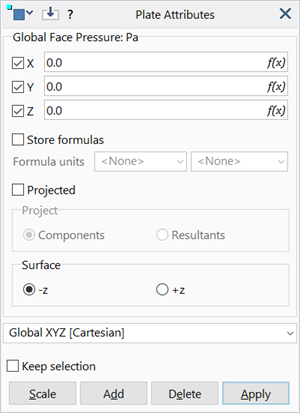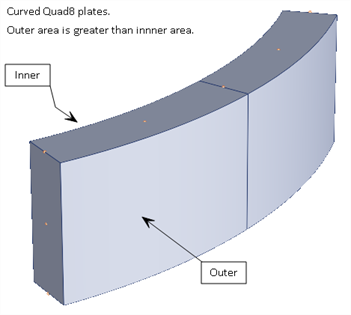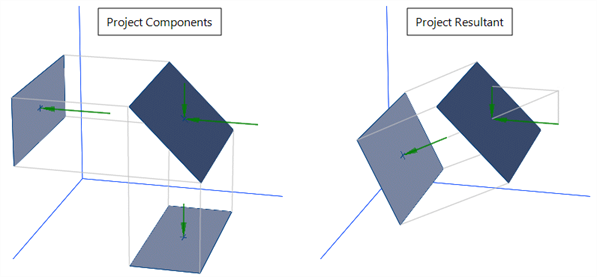Plate Attributes: Face Global Pressure

Description
Assigns uniform global pressure on the surfaces of selected plate elements using three orthogonal components and a coordinate system.
Different pressures can be applied on the -z and +z surfaces of a plate. The sign of a pressure component refers to its direction with respect to the coordinate system.
The magnitude of the resultant force is equal to pressure × plate surface area.
As the pressure is applied to the outer surfaces of a plate, not to the mid-surface, the area over which it acts depends on the surface, the thickness and the curvature of the plate. The area can also depend on the plate offset attribute, if applied, and on whether the pressure is projected or not.

In geometric nonlinear analysis, the direction of the pressure does not change as the plate deflects and deforms.
Pressure attributes are load case dependent.
Dialog
Global Pressure X / Y / Z
Three components of pressure.
Projected
If set, the pressure acts on a projected area.
If not set, the pressure acts over the entire plate surface area.
Two projection methods are available:
-
Components
Each pressure component in the global Cartesian coordinate system acts independently. Each component is applied over the projection of the plate surface onto a plane normal to the pressure direction.
-
Resultant
The pressure acts over the projection of the plate surface onto a plane normal to the direction specified by the resultant of the three component pressure values.

In geometric nonlinear analysis, the total load generated for projected pressure can change depending on the deflection and deformation of the plate, although the direction remains constant.
Coordinate System
The coordinate system (UCS) in which the pressure components are defined.
The UCS is used only to define the global Cartesian components of the force. Subsequent changes to the UCS do not affect the direction or magnitude of the force.
Surface
The surface on which the pressure is applied.
-
+z
Applies the pressure to the +z surface of the plate.
-
-z
Applies the pressure to the -z surface of the plate.
To apply global pressure on both surfaces of the plate, the attribute needs to be applied twice, once per surface.
Common Controls
- Components
- Equation Editor
- Store formulas / Formula units
- Retrieve from model
- Keep selection
- Scale / Add / Delete / Apply
Units
Stress (e.g., Pa, psi).
See Also